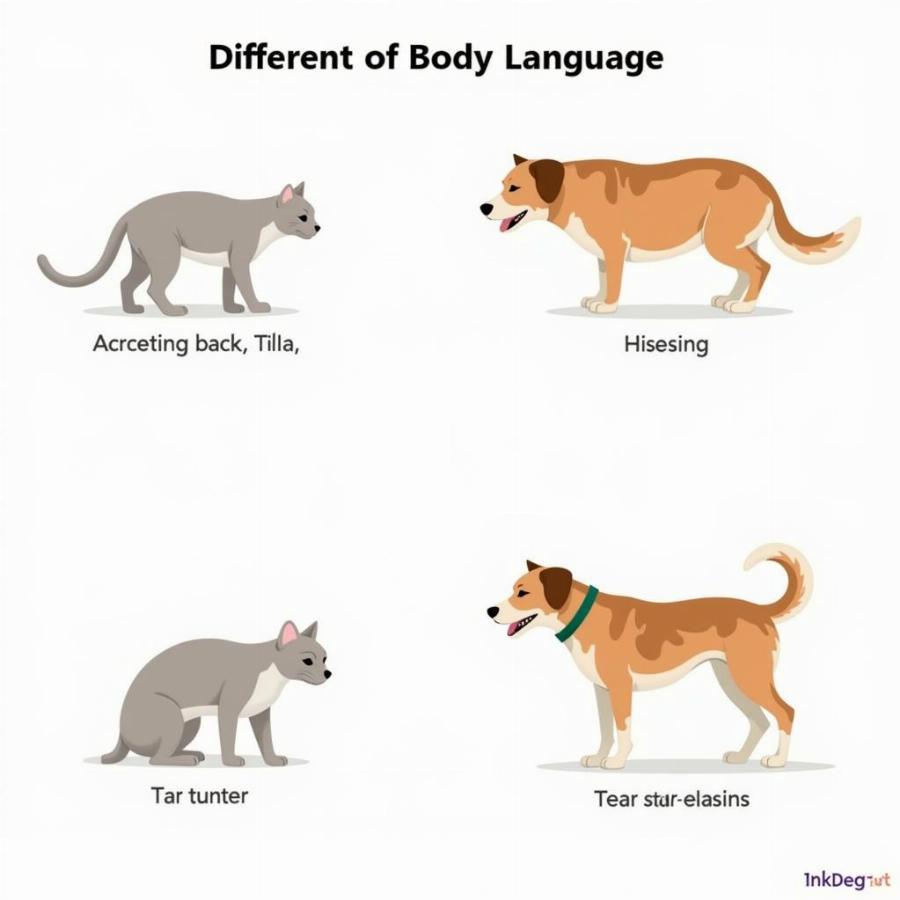Dogs, known for their boisterous energy and often fearless nature, can sometimes display a surprising timidity around cats. This seemingly paradoxical behavior puzzles many dog owners, leading them to wonder: why are dogs scared of cats? The answer isn’t always simple and often involves a combination of factors, including past experiences, socialization, body language, and even breed-specific predispositions.
Decoding Canine Fear: Understanding Why Dogs are Afraid of Felines
Several factors contribute to a dog’s fear of cats. Early experiences, especially during puppyhood, play a crucial role. A negative encounter with a cat, such as being scratched or hissed at, can create a lasting fear. Similarly, a lack of early socialization with cats can leave a dog unprepared for feline encounters, resulting in anxiety and fear. Even a dog’s natural prey drive can be redirected into fear if the cat exhibits confident, assertive behavior.
Breed also plays a part. Some breeds are naturally more cautious or sensitive, making them more prone to developing fear-based behaviors. On the other hand, breeds traditionally used for hunting small game may exhibit a more predatory instinct, but even these dogs can become intimidated by a confident cat. Understanding your dog’s breed-specific tendencies can help you anticipate and address potential fear issues.
Body Language: The Silent Conversation Between Cats and Dogs
Cats and dogs communicate through subtle body language cues that often go unnoticed by humans. A cat’s arched back, puffed-up fur, hissing, and swatting are clear signals of displeasure or aggression, which can easily intimidate a dog. Dogs, especially those unfamiliar with feline communication, might interpret these signals as threats, triggering a fear response. Conversely, a cat’s calm demeanor and slow blinks can signify contentment and friendliness, which may help a dog feel more at ease.
 Cat and Dog Body Language
Cat and Dog Body Language
Is Your Dog Scared of Cats? Look for These Telltale Signs
Identifying fear in dogs can be tricky, as it can manifest in various ways. Some common signs include tucked tails, flattened ears, avoidance, whining, barking, and even submissive urination. A fearful dog might also try to hide, tremble, or display panting and lip licking. Recognizing these signs is crucial for intervening and helping your dog overcome its fear.
How can I tell if my dog is afraid of my cat?
If your dog exhibits any of the behaviors mentioned above, such as tucked tail, flattened ears, avoidance, or submissive urination in the presence of your cat, it’s a strong indication of fear. Observe their interactions closely to determine the level of discomfort your dog experiences.
Helping Your Dog Overcome Its Fear of Cats
Addressing a dog’s fear of cats requires patience, consistency, and positive reinforcement. Start by creating positive associations with cats. This can involve rewarding calm behavior in the presence of a cat, using treats and praise. Gradual desensitization, where the dog is slowly exposed to a cat at a safe distance, can also be effective. Ensure both animals have their own safe spaces where they can retreat and feel secure. You can also try a dog tunnel toy to provide a safe and engaging space for your dog.
Can a dog that is scared of cats ever get along with one?
Absolutely! With patience and proper introduction techniques, even the most timid dog can learn to coexist peacefully, and sometimes even become friends, with a cat. Remember, slow and steady wins the race. A cat tree for dogs can also help create a shared space for both animals.
Conclusion: Fostering Harmony Between Canine and Feline Companions
While a dog’s fear of cats might seem puzzling, it’s a behavior rooted in instinct, experience, and communication. By understanding the underlying causes and implementing appropriate strategies, you can help your dog overcome its fear and create a harmonious environment for both your canine and feline companions. Remember to be patient and consistent, and never force interactions. Positive reinforcement, gradual desensitization, and a respectful understanding of each animal’s needs are key to fostering peaceful coexistence. Knowing when a cat attacked by dog situation occurs is also important. Consider a tunnel for dogs to give your dog a safe space.
FAQ:
- Why is my dog suddenly afraid of cats?
- Can I train my dog to not be scared of cats?
- What should I do if my dog chases my cat?
- How can I introduce my dog to my cat safely?
- Do certain dog breeds get along better with cats?
- Is it normal for a dog to be scared of a cat?
- What are the signs of a dog being aggressive towards a cat?
Further Reading:
- What shows do dogs like to watch?
Beaut Dogs is your go-to resource for all things related to dog breeds, care, and training. We provide expert advice and valuable insights to help you navigate the wonderful world of dog ownership. For personalized guidance and detailed answers to your specific questions, don’t hesitate to reach out to us via Email: [email protected]. Beaut Dogs is here to support you every step of the way. Visit us at https://beautdogs.com.